Explore Quang Binh Province - Central Vietnam Travel, Asia
Quang Binh, a coastal province in Central Vietnam, is an emerging gem on the country’s tourism map. Known for its breathtaking natural landscapes, including sprawling beaches, lush forests, and majestic mountains, Quang Binh offers travelers an opportunity to explore some of the most unspoiled environments in Southeast Asia. From the world-renowned Phong Nha-Ke Bang National Park to the mysterious depths of Son Doong Cave, Quang Binh is a paradise for nature lovers and adventure seekers alike. This destination is not just about nature; it’s steeped in history and rich in cultural heritage, making it a must-visit destination for those who want to experience the true essence of Vietnam.
Population: Approximately 900,000 in 2022.
Economy: Quang Binh's economy is driven by tourism, agriculture, and fishing. The province benefits from its natural attractions, including caves and beaches, which attract visitors and support local businesses.
Landmarks: Famous for the Phong Nha-Ke Bang National Park, Son Doong Cave, and Ho Chi Minh Trail.
Vietnam
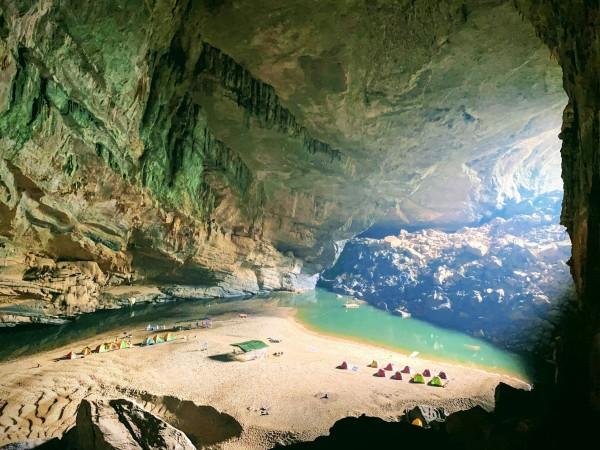
Overview of Quang Binh
History & Culture Influence
Quang Binh has a history as deep and varied as its landscapes. The province has been shaped by centuries of cultural influences, from the ancient Champa Kingdom to the Nguyen Dynasty. During the Vietnam War, Quang Binh played a crucial role as a gateway for the Hồ Chí Minh trail, and remnants of this period can still be explored today. The locals take pride in their heritage, preserving traditional festivals, folk songs, and dances that have been passed down through generations. The blend of history and culture in Quang Binh provides a deep understanding of the province's identity, making it more than just a scenic destination but a place where history lives on.
Interaction with The Locals
Quang Binh is home to approximately 900,000 people, with a diverse population that reflects the rich cultural tapestry of Vietnam. The majority are ethnic Vietnamese (Kinh), but the province is also home to ethnic minorities such as the Bru-Van Kieu and Chut, who contribute to the region's cultural diversity. The people of Quang Binh are known for their warmth, hospitality, and resilience, shaped by a history of overcoming natural and wartime challenges. Life here is often centered around agriculture, fishing, and increasingly, tourism, with locals eager to share their traditions and stories with visitors.
Grab the chance to meet local Vietnamese and experience their daily life with our Vietnam tour here.

Quang Binh's natural beauty - © Vietnam Government News
Top Attractions in Quang Binh
Quang Binh is home to some of Vietnam’s most stunning natural and cultural attractions. These attractions showcase the diverse beauty and rich history of Quang Binh, making it a must-visit destination for anyone traveling to Vietnam.
- Phong Nha-Ke Bang National Park: This UNESCO World Heritage Site is the crown jewel of Quang Binh. Phong Nha-Ke Bang, well-known for its vast cave networks and karst scenery, is an explorer's dream come true. Two of the world's largest dry caverns, Paradise Cave, and Phong Nha Cave, with its subterranean river, are highlights.
- Son Doong Cave: As the world’s largest cave, Son Doong is an unparalleled experience. Discovered only in the early 2000s, this cave is a must-visit for serious adventurers. The cave’s immense size and unique ecosystem make it a one-of-a-kind destination that draws explorers from all over the globe.
- Nhat Le Beach: Nhat Le Beach boasts sparkling white sands and crystal-clear blue waves for people who want to unwind. It's the perfect location for relaxing by the water, swimming, and sunbathing.
- Tu Lan Cave System: Located near the border of Laos, the Tu Lan Cave System is an adventure lover’s dream. This complex of over 10 caves features underground rivers, waterfalls, and stunning stalactites and stalagmites. Trekking through the jungle and swimming through caves make for an exhilarating experience.
- Ho Chi Minh Trail: History buffs will appreciate a visit to the Ho Chi Minh Trail, a historic route used during the Vietnam War. The trail passes through Quang Binh and offers a glimpse into the country’s wartime history, with remnants of the past still visible along the way.
- Bong Lai Valley: A hidden gem, Bong Lai Valley offers a serene countryside experience. Visitors can explore local farms, taste homemade peanut butter at The Duck Stop, or enjoy a leisurely bike ride through this picturesque valley.
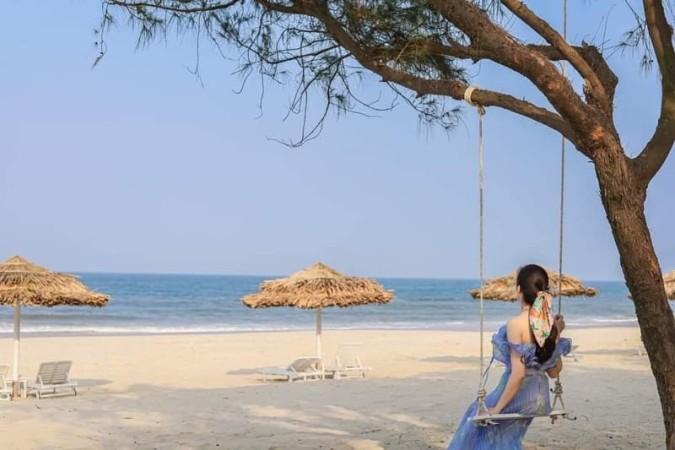
Nhat Le Beach - © Vietnam Tourism
Must-Try Dishes in Quang Binh
Quang Binh’s culinary tradition is a delightful journey into the heart of Central Vietnamese cuisine. The province offers a variety of dishes that reflect its coastal location and agricultural traditions.
- Banh Bot Loc (Clear Shrimp and Pork Dumplings): Made with tapioca flour and packed with pork and shrimp, these transparent dumplings are frequently wrapped in banana leaves and steam-cooked. The chewy texture and savory filling make them a popular local snack.
- Banh Xeo Quang Hoa (Quang Hoa Pancakes): Unlike the southern version, these crispy rice pancakes are smaller and thicker, filled with a mixture of shrimp, pork, and bean sprouts. They're usually served with a side of fresh herbs and a zesty dip.
- Lau Ca Khoai (Snakehead Fish Hot Pot): A traditional hotpot dish made with snakehead fish, known for its firm and flavorful flesh. It’s cooked with a variety of vegetables and herbs, offering a perfect blend of flavors that’s both warming and satisfying.
- Goi Ca Ngheo (Shark Salad): A unique dish that reflects Quang Binh’s coastal location, this salad is made from thin slices of shark meat, marinated with herbs, lime juice, and chili. It’s a refreshing and flavorful dish that’s both light and zesty.
- Ruou Sim (Myrtle Wine): While not a dish, Rượu Sim is a local specialty that’s worth trying. This wine is made from myrtle fruit, known for its sweet and slightly tart flavor. It’s often enjoyed as an accompaniment to meals or as a refreshing drink.
- Banh Loc La (Tapioca Dumplings in Banana Leaves): These bite-sized dumplings are similar to Bánh Bột Lọc but are steamed in banana leaves, giving them a distinctive aroma. They’re often filled with shrimp or pork and served with a savory dipping sauce.
Discover more must-try dishes around Vietnam in this article.
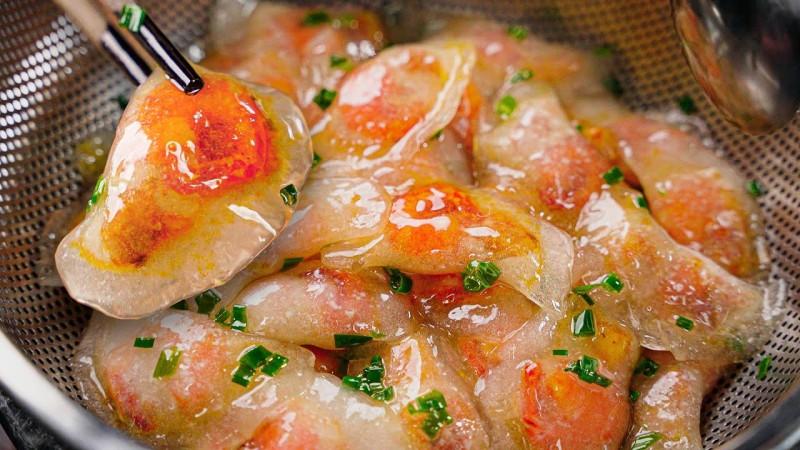
Banh Bot Loc (Clear Shrimp and Pork Dumplings) - © Co Ba Binh Duong
Festivals & Local Celebrations
Whale Worshiping Festival
This unique festival, typically held in the early months of the lunar calendar, is one of the most important celebrations for coastal communities in Quang Binh. The Whale Worshiping Festival is deeply connected to the fishing culture of the province. Fishermen believe that whales are sacred creatures that protect them at sea, and this festival is a way to express gratitude and seek blessings for a bountiful fishing season.
Tet Holiday (Lunar New Year)
The festival usually takes place in late January or early February, marking the beginning of the lunar new year. During Tet, families come together to honor their ancestors, decorate their homes with peach blossoms and kumquat trees, and prepare special dishes like banh chung (square sticky rice cake). The streets of Quang Binh are filled with the festive sounds of traditional music, dragon dances, and fireworks.
Discover how the locals cerebrate Tet Holiday in northern Vietnam here.
Mid-Autumn Festival
The Mid-Autumn Festival is celebrated on the 15th day of the 8th lunar month and is a joyous occasion primarily for children. The festival is marked by the sight of colorful lanterns illuminating the night, as children parade through the streets with their star-shaped lanterns. Families get together in Quang Binh to devour mooncakes with savory or sweet fillings, which stand for harmony and completion. The festival also features lion dances, where performers mimic the movements of a lion to bring good luck and fortune.

Dragon and Lion Dancing during Mid-Autumn Festival and Tet Holiday - © Bach Hoa Xanh
What to Do in Quang Binh
- Cave Exploration: Quang Binh is famous for its extensive cave systems. From exploring the world’s largest cave, Son Doong, to kayaking through the underground rivers of Phong Nha Cave, these adventures offer thrilling experiences for outdoor enthusiasts.
- Trekking in Quang Binh: The rugged landscapes of Quang Binh are perfect for trekking and hiking. Trails in Phong Nha-Ke Bang National Park lead you through dense jungles, limestone mountains, and picturesque valleys, offering breathtaking views and a chance to spot rare wildlife. Trekking is a very popular activity in many provinces in Central Vietnam.
- Quang Binh River Cruises: Take a relaxing boat cruise along the Son River or the Chay River, where you can enjoy the scenic beauty of the countryside, visit local villages, and explore hidden caves along the way.
- Beach Activities: Quang Binh’s coastline boasts beautiful beaches like Nhat Le and Da Nhay. Swimming, tanning, and water activities like jet skiing and parasailing are available to visitors.
- Quang Binh Cultural Tours: Immerse yourself in the local culture by joining guided tours that take you to historic sites, traditional villages, and local markets. These tours provide insights into the province’s history, culture, and way of life.
Shopping in Quang Binh
- Dong Hoi Market: The largest market in the province, Dong Hoi Market is a bustling spot where you can find everything from fresh produce and seafood to local handicrafts. It's a fantastic location to purchase souvenirs and get a taste of the local way of life.
- Phong Nha Souvenir Shops: Near Phong Nha-Ke Bang National Park, you’ll find small shops selling unique souvenirs like handwoven textiles, bamboo crafts, and local artwork. These items make for meaningful mementos of your trip.
- Traditional Handicrafts: Quang Binh is known for its traditional crafts, including pottery, wood carving, and conical hats. Visiting a local workshop or craft village allows you to purchase these items directly from the artisans who create them.
- Specialty Foods: Don’t miss the chance to buy local delicacies such as dried seafood, fish sauce, and rice paper. These items are popular among visitors for their quality and authentic taste, perfect for sharing with friends and family back home.
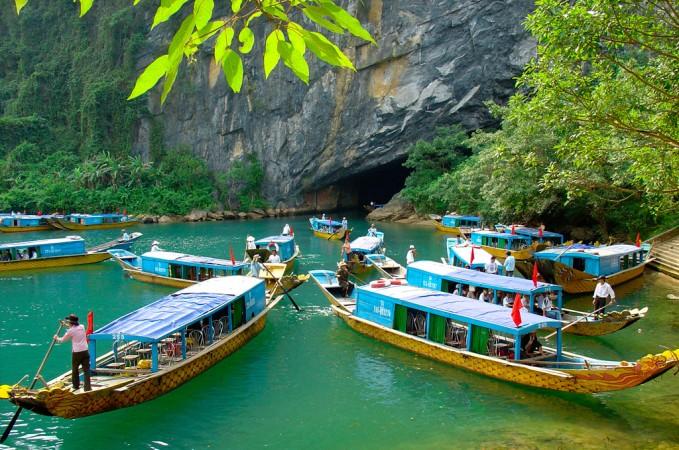
Quang Binh River Cruises - © Vietnam Tourism
Weather in Quang Binh: Best Time to Visit
Dry Season in Quang Binh
Quang Binh experiences pleasant temperatures and comparatively low humidity throughout the dry season. The range of daytime temperatures is 25°C to 35°C (77°F to 95°F). This is an ideal time for outdoor activities and exploring the province’s natural attractions, such as the Phong Nha-Ke Bang National Park and beautiful coastal areas. The weather is generally pleasant, with plenty of sunshine and minimal rain.
Wet Season in Quang Binh
The wet season brings heavier rainfall and higher humidity, with temperatures ranging from 20°C to 30°C (68°F to 86°F). Typhoons and tropical storms are more common during this period, particularly from September to November. While the rains can be heavy, they often come in short, intense bursts, and the landscape becomes lush and green. Visitors should be prepared for occasional disruptions and check weather conditions before traveling. During wet season, you can consider visiting other places around Vietnam that offer wonderful conditions.
Best Time to Visit Quang Binh
For the best experience, plan your visit during the dry season when the weather is more predictable and conducive to outdoor exploration. However, if you prefer fewer crowds and don’t mind occasional rain, the wet season can also offer a unique and quieter experience.
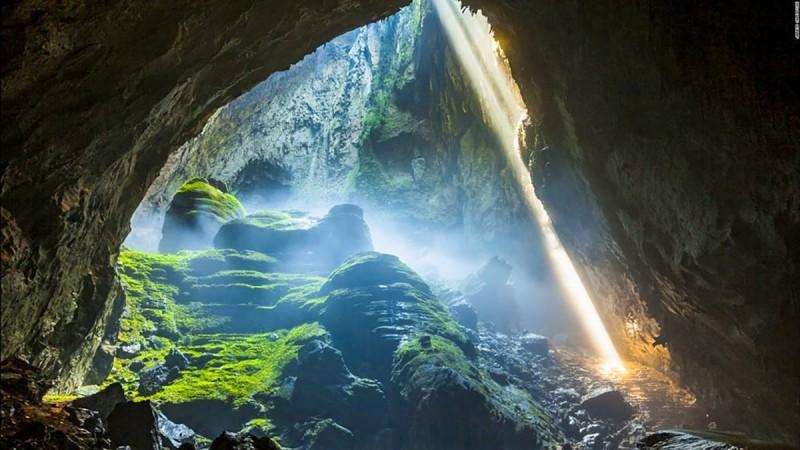
Dry Season is the best season for cave exploring in Quang Binh - © Vietnam Tourism
Culture Etiquette in Quang Binh
- Dress Modestly: When visiting religious sites or traditional villages, it’s important to dress modestly. Covering shoulders and knees is appreciated, and avoiding revealing clothing shows respect for local customs.
- Respect Religious Practices: Quang Binh is home to various temples and pagodas. When visiting these sacred places, maintain a respectful demeanor, speak softly, and follow any specific guidelines, such as removing shoes before entering.
- Politeness and Greetings: Greetings in Vietnam are often accompanied by a smile and a slight bow of the head. A handshake is common among men, while women may nod or bow.
- Respect for the Environment: Quang Binh’s natural beauty is a point of pride for locals. Be mindful of littering and follow guidelines for preserving the environment, especially when visiting national parks and natural attractions.
Essential Travel Information
Getting Around Quang Binh
Navigating Quang Binh is relatively straightforward, with several transportation options available to suit different needs:
- Taxis and Ride-Sharing: In urban areas like Dong Hoi, taxis and ride-sharing services offer a comfortable and easy way to travel between attractions and accommodations. They are a convenient choice for getting around the city.
- Motorbike Rentals: For a more adventurous and flexible option, renting a motorbike is popular among travelers. It allows you to explore Quang Binh at your own pace, particularly in more remote areas.
- Buses: Public buses provide a cost-effective way to connect major cities and towns within Quang Binh, as well as to neighboring provinces. They are suitable for traveling longer distances and reaching popular destinations.
- Bicycle Rentals: For a leisurely exploration of the local area, consider renting a bicycle. Many hotels and guesthouses offer bike rentals, making cycling an excellent way to experience the scenic beauty of Quang Binh up close.
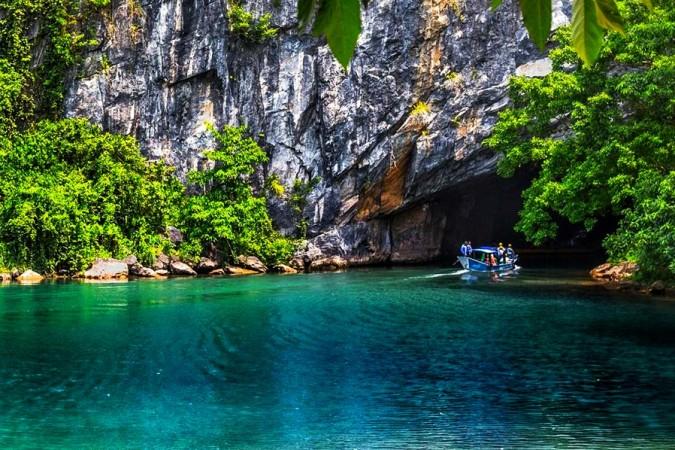
Explore every natural landmark with Quang Binh Boat Cruises - © Vietnam Tourism
ATM & Banking Services
Handling your finances in Quang Binh is convenient with numerous banking and ATM options available. ATMs are widely accessible in Dong Hoi City and other major towns, providing services such as cash withdrawals and balance inquiries. Various banks throughout the region offer essential services like currency exchange, cash deposits, and account management. While many hotels, restaurants, and shops in urban areas accept major credit cards, it's advisable to carry some cash, particularly when traveling to rural areas or smaller establishments.
Where to Stay in Quang Binh
- Hotels: From luxury hotels to budget-friendly options, Dong Hoi City and Phong Nha offer a variety of hotels. Choose from well-known international chains for high-end amenities or local hotels for a more authentic experience.
- Homestays: Staying at a homestay will allow you to experience the local life of Quang Binh people. This option allows you to interact with local families, enjoy homemade meals, and gain a deeper understanding of Quang Binh’s culture and traditions.
- Resorts: If you’re looking for a relaxing getaway, resorts along the coastline offer beautiful views and luxurious amenities. These are ideal for those seeking a tranquil environment with access to private beaches and top-notch facilities.
- Hostels: Budget travelers can find hostels in Dong Hoi and other popular areas. Hostels provide more affordable lodging in addition to the opportunity to network with other visitors.
- Eco-Lodges: For eco-conscious travelers, Quang Binh has eco-lodges that emphasize sustainable practices and offer a unique experience surrounded by nature.
Articles for you

Explore Yala National Park - Sri Lanka Travel, Asia
Tucked away in Sri Lanka’s southeastern corner, Yala National Park is where wild nature meets deep tradition. Known worldwide for its leopard population, the park is also home to elephants, sloth bears, crocodiles, and hundreds of bird species. Beyond wildlife, Yala opens doors to a cultural landscape dotted with ancient temples, Buddhist ruins, and coastal villages. For travelers seeking more than just a safari, Yala offers a chance to explore eco-tourism, local communities, and sacred heritage sites.
Population: The Yala National Park area doesn’t have a human population.
Economy: The economy around Yala National Park thrives on a blend of eco-tourism, agriculture, and local services. Safari tours, eco-lodges, and cultural experiences drive steady income for nearby towns like Tissamaharama and Kataragama, supporting thousands of families.
Landmarks: Famous for Block I of Yala and wildlife encounters, including elephants, sloth bears, crocodiles, and exotic bird species.

Explore Galle - Sri Lanka Travel, Asia
Nestled on Sri Lanka’s southern coastline, Galle is a vibrant city where history meets the sea. Its cobbled streets, colonial architecture, and serene beaches make it a must-visit destination for travelers seeking a blend of culture, adventure, and relaxation. A UNESCO World Heritage site, Galle captivates visitors with its Dutch Fort, bustling markets, and friendly locals. Whether you’re exploring the ramparts at sunset or savoring fresh seafood by the shore, Galle promises an unforgettable journey into Sri Lanka’s heritage.
Population: Approximately 113,000 in 2023.
Economy: Galle’s economy thrives on tourism, trade, and fisheries. The city’s historic fort, colonial architecture, and coastal charm draw thousands of international visitors each year, making tourism its main economic driver. Fishing remains vital for local livelihoods, supplying fresh seafood across the region.
Landmarks: Famous for the Galle Fort, Dutch Reformed Church & Maritime Museum, and Unawatuna Beach.

Explore Bentota - Sri Lanka Travel, Asia
Nestled along Sri Lanka’s southwestern coast, Bentota is a tropical paradise that blends golden beaches, vibrant culture, and thrilling adventures. Famous for its calm waters, luxury resorts, and scenic river estuary, Bentota has become a top destination for travelers seeking both relaxation and authentic experiences. From serene beach walks at sunrise to adrenaline-pumping water sports, this coastal town offers a perfect balance of leisure and exploration. With its proximity to Colombo and Galle, Bentota is easy to reach, making it an ideal stop for both short escapes and extended holidays.
Population: Approximately 37,000 in 2023.
Economy: Bentota’s economy thrives mainly on tourism, which drives local businesses such as hotels, restaurants, and wellness retreats. The town also benefits from fishing, coconut cultivation, and handicrafts like wood carving and batik textiles. Many residents rely on the growing demand for water sports and Ayurvedic treatments, making tourism the backbone of both income and employment in the area.
Landmarks: Famous for Bentota Beach, Bentota River Safari, and Kande Vihara Temple.

Explore Mirissa - Sri Lanka Travel, Asia
Mirissa is a charming coastal town on Sri Lanka’s southern shoreline. Known for its golden beaches, turquoise waters, and vibrant marine life, it has become a must-visit stop for travelers exploring the island. Many come for whale watching, surfing, and sunset views at Coconut Tree Hill, but Mirissa offers much more than postcard beauty. The fishing boats you see anchored by the bay carry generations of stories. Local traditions, delicious cuisine, and a laid-back rhythm of life shape every visitor’s experience.
Population: Approximately 4,700 in 2023.
Economy: Mirissa’s economy is largely shaped by its coastal location. Fishing has long been the backbone of local livelihoods, with generations relying on the Indian Ocean for income. In recent decades, tourism has become the main driver of growth, thanks to whale watching, surfing, and beachside hospitality.
Landmarks: Famous for Mirissa Beach, Coconut Tree Hill, and Parrot Rock Bridge.

Explore Nuwara Eliya - Sri Lanka Travel, Asia
Tucked away in the Central Highlands of Sri Lanka, Nuwara Eliya is often called “Little England”. With its rolling tea plantations, cool misty mornings, and colonial charm, this mountain town feels like a step into another world. Travelers come here to breathe fresh air, walk through flower gardens, sip the finest Ceylon Tea, and enjoy a pace of life far from the island’s busy cities. Whether you’re drawn by scenic landscapes, heritage architecture, or the warmth of its people, Nuwara Eliya is a destination that blends nature, culture, and history in perfect harmony.
Population: Approximately 781,000 in 2023.
Economy: Nuwara Eliya’s economy thrives mainly on tea production, as it sits in the heart of Sri Lanka’s central highlands, famous worldwide for Ceylon Tea. The city also benefits from a growing tourism industry, attracting visitors with its colonial charm, cool climate, and scenic landscapes.
Landmarks: Famous for Gregory Lake, Hakgala Botanical Garden, and Victoria Park.

Explore Sukau - Malaysia Travel, Asia
Nestled on the banks of the Kinabatangan River in Sabah, Malaysian Borneo, Sukau is a destination where wildlife, culture, and conservation come together. Known as one of Asia’s top spots for river safaris and eco-tourism, this quiet village offers a front-row seat to encounters with Bornean orangutans, pygmy elephants, proboscis monkeys, and exotic birdlife.
Population: Approximately 1,400 in 2019.
Economy: Sukau’s economy is shaped by its riverine location and natural resources. Traditionally, the Orang Sungai community relied on fishing, small-scale farming, and forest gathering for their livelihood. Today, the village has shifted toward eco-tourism, with river cruises, jungle trekking, and homestays providing income.
Landmarks: Famous for the Kinabatangan River cruises, Gomantong Caves, and Ox-bow lakes and wetlands.
